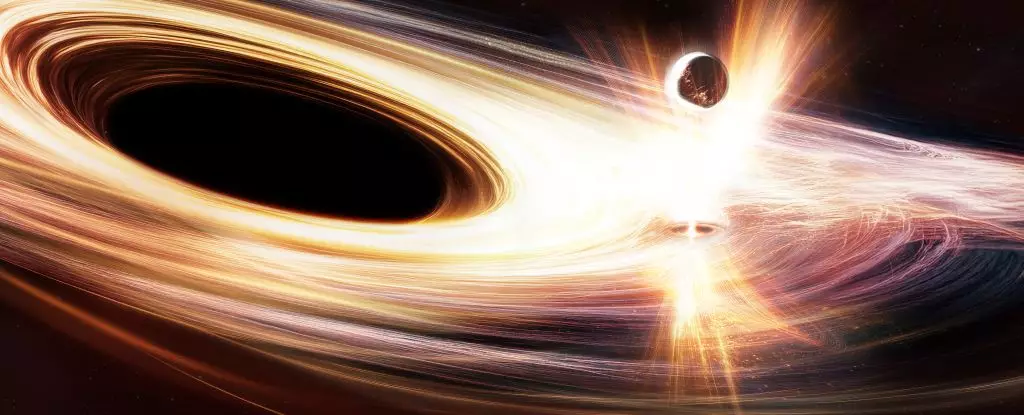In the grand theater of the cosmos, few phenomena rival the enigma presented by supermassive black holes. One such black hole, nicknamed Ansky, has captivated the imagination of scientists and astronomy enthusiasts alike. Residing 300 million light-years from Earth at the core of the galaxy SDSS1335+0728, Ansky has sparked a wave of intrigue since it began exhibiting unusual activity in 2019. Unlike typical black holes that often reveal their presence through quiet consumption of surrounding matter, Ansky has erupted with an intensity and duration of light that has prompted astrophysicists to rethink their understanding of these cosmic titans.
Understanding Black Holes Beyond the Vacuum Cleaner Metaphor
The conventional portrayal of black holes as insatiable cosmic vacuum cleaners oversimplifies their intricate existence. Yes, black holes possess immense gravitational powers, allowing them to capture surrounding material, but their behavior is not a relentless cycle of swallowing and digesting matter. Rather, supermassive black holes demonstrate dynamic phases of activity and dormancy. For instance, Sagittarius A*, the black hole anchoring our Milky Way galaxy, spends much of its existence in a subdued state, offering valuable lessons on the lifecycle of black holes and their influence on galactic environments. Ansky’s unexpected awakenings complicate this binary model of quiescence and activity, challenging the frameworks that astronomers have employed to study these celestial heavyweights.
Ansky’s Unprecedented Eruptions
Astrophysicists, particularly those on the cutting edge of observational astronomy, have long been fascinated by quasi-periodic eruptions—intermittent bursts of X-rays and other electromagnetic radiation from black holes. However, Ansky’s eruptions showcase a staggering complexity that defies established patterns. According to Joheen Chakraborty from MIT, these bursts emit tenfold the luminosity of typical eruptions and last significantly longer. Each flash lasts about 4.5 days, a duration never before recorded in other black holes. The sheer magnitude and frequency of energy released force researchers to confront fundamental questions about the mechanics of the black hole and its interactions with the surrounding cosmos.
The Implications for Cosmology and Galactic Evolution
Understanding Ansky becomes more crucial when considering its implications for galactic evolution. Supermassive black holes play a pivotal role in shaping their host galaxies. The active phases during which they consume vast quantities of material influence star formation rates and chemical compositions within galaxies. Ansky’s bursts may provide insights into how such black holes influence the broader galactic context. If ongoing studies validate the unique characteristics of Ansky’s activity, they might offer a glimpse into a new class of black hole phenomena—one that could redefine our understanding of black hole development over cosmic time.
Rethinking Accretion Models
Traditionally, the models explaining black hole activity have centered on the idea that interactions with surrounding stars or matter trigger eruptions through gravitational forces. Yet, Ansky’s behavior raises questions that challenge these models. The nature of its light, spanning different wavelengths, and the duration of its flares suggest that simpler models may need to be expanded or entirely restructured. Erwan Quintin of the European Space Agency points out that these observations indicate that there could be deeper mechanisms at play, possibly relating to gravitational waves—ripples in spacetime that LISA, a future space observatory, may seek to investigate.
The Future of Black Hole Research
The discoveries surrounding Ansky signify a transformative moment in astrophysical research. They urge a reevaluation of both the physical mechanisms behind black hole behavior and broader theories of cosmic evolution. While the light emitted by black holes remains a complex phenomenon, studies like those of Ansky illuminate paths for future research and observation. As astrophysicists continue to refine their tools and methodologies, Ansky may very well be a seed that sprouts new areas of inquiry and understanding.
The excitement generated by Ansky is more than anecdotal; it’s a clarion call for further exploration. The mystery revolving around this black hole, with its unprecedented behaviors, prompts researchers to dig deeper into both classical theories and to embrace innovative interpretations of data. As our technology evolves, so too will our grasp of these enigmatic giants that beckon from the depths of space, inviting us to uncover their secrets.

